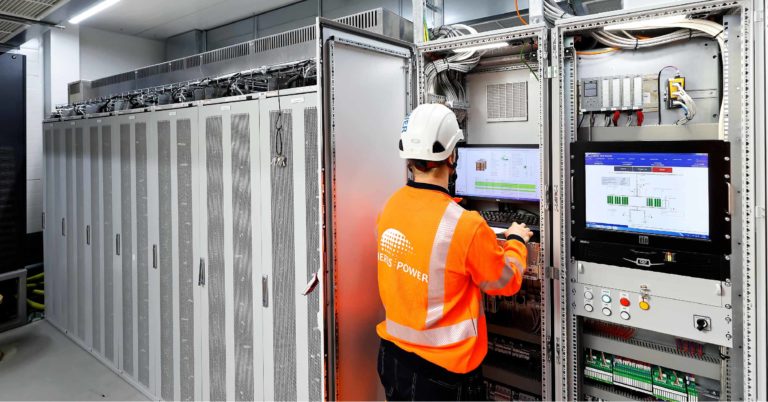
The efficient duo of energy production in remote mines: energy storage systems and renewable energy
The solution to support mines in the transition to renewables can be found in energy storages. This enables the installation of energy storage systems in remote mines in the future. Our Merus® Energy Storage System has additional technical benefits for the industry, on top of making the transition to renewables possible. In this blog, we explain:
- The main issues of energy production in remote mines
- The dilemma of diesel generators and renewables
- Detailed payback calculations of solar power production combined with Merus® Energy Storage System in an off-grid microgrid
- Technical challenges to take into consideration when switching to renewables
- The overall benefits of our Merus® ESS Energy Storage System as a part of an islanded mine grid
- How to produce a stable grid with Merus® ESS Energy Storage System
And more!
Energy production in remote mines
Mining is a very energy-intensive industry. A lot of energy is used in all parts of the mining process, such as raw material extraction, crushing, grinding, filtration, and transport. How this energy is produced and how efficiently it is used is directly linked to how productive and ecological the mining process is.
Driven both by pressure to decarbonize the industry[1] and by the lowered production cost for electrical energy in photovoltaic and wind power plants[2], among other renewable technologies, it is expected that the mining industry will progressively transition into using these renewable energy sources.
This can already be observed in the activities of big conglomerates, such as BHP and Rio Tinto, who have accelerated their procurement of renewable energy. According to Bloomberg NEF[3], “Miners have contracted for 5.9GW of clean energy in the last decade – three-quarters of which was signed up in the past two years.”
The transition to using renewable energy sources is not without some challenges to tackle. Many mines are located in remote sites, where the raw material to extract is plenty, but where no access to electricity from the grid infrastructure is available. To secure power production locally for the energy needs of the various processes, the mines are still heavily reliant on diesel generators.
Diesel generators or renewable energy sources?
Diesel generators consume fuel, whose total price in remote locations is considerably higher than the purchase price. The total fuel price also includes costs from transportation, storage, and guarding. The carbon footprint and particle emissions from burning fuel are also considerable compared to renewable energy sources, even if the footprint of their production is taken into account.
The initial capital investment for diesel generators may be lower than investing in local renewable production, but the fuel, operation, and maintenance costs make up for it in the long run, and solar and wind power become cheaper per produced kWh.
This, combined with the difference in emissions, makes a strong case for using renewable energy sources in local production. Note that this is not an either-or situation: the best balance between cost-efficiency, carbon footprint, and feasibility may be struck with a solution combining both generators and renewable energy production.
Technical challenges when transitioning to renewables
Unfortunately, designing and maintaining an islanded electric network is not as simple as choosing an energy source and then plugging the mining machinery in. Replacing diesel generators with renewable energy technologies also requires addressing some technical challenges. Rotating generators have several important characteristics for an electric network:
- Their production can be controlled predictably (as opposed to renewables which are dependent on weather), as long as fuel is available.
- They are able to form an electric network and provide inertia.
- They can provide short circuit current reliably to ensure that the network protections such as fuses and relays work correctly, and the network is thus safe for personnel.
- With enough generators, the electric network becomes strong enough to absorb transient events (motors starting and stopping, consumption peaks) without losing stability.
Renewable energy sources can help in the above-mentioned points, but they cannot produce a stable electric network and a continuous mining process alone. Mining machinery such as stone crushers, winders, conveyors, etc. need power even if the wind is not blowing or the sun is not shining. On the other hand, if the sun is up and the wind is strong, it would be a waste to not capture this energy somehow even if the miners are on holiday.
To summarize, the production cannot necessarily be instantaneously matched with the mine process demand, which can cause stability issues in the grid. With diesel generators, power production can be matched with the demand by operating a certain number of generators according to the predicted demand.
Merus® Energy Storage Solution as part of an islanded grid
The situation changes if local renewable production is coupled with an energy storage system, that can provide the system with a buffer between production and consumption, which may take place at different times.
Our Merus® ESS is the perfect solution for such applications as it allows smooth integration and efficient use of renewable energy. It also ensures a continuous power supply, makes sure that network protection works, and has extremely fast response time and high-quality electricity. With its easy configurability and key functions such as peak shaving, black start ability, voltage, and frequency control, and power quality compliance, Merus® ESS is much more than just a passive energy-storing component for its users.

Merus® ESS – Energy storage system
Merus® Energy Storage System is a scalable lithium-ion battery energy storage system fully designed by Merus Power.
The many different forms of energy storage technology
Energy storage systems can be based on various energy storage technologies. The most used one is Lithium-ion battery technology. It is proven and mature, and its advantages in mine applications are numerous:
- A lot of power and energy can be packed into a relatively small space with a relatively small mass. Lithium-ion batteries are very power- and energy-dense. This makes it easier to transport and install them in any location.
- Likewise, because lithium-ion batteries are not dependent on any external factors such as geographical formations, they can be placed anywhere.
- The response time of the batteries is instantaneous. The power ramp rates for charging and discharging the battery are faster than with a rotating machine.
Producing a stable grid with energy storage systems
To produce a stable grid, an energy storage system is designed with suitable nominal power and nominal energy. The energy storage system’s nominal power can be designed to feed all the mine loads alone, or possibly optimized to work together with gensets or other sources of backup power. The required short-circuit level should also be taken into consideration in specifying the nominal power so that all the network protections operate correctly.
The specification of the nominal energy of an energy storage system is a trickier question: How long does an energy storage system need to be able to feed the mine loads?
- Should the mine operator procure a battery that is able to feed all the mine loads for 24 hours?
- Or perhaps only a portion of the loads for 30 minutes?
The answer to the previous question would be different for each mine. A statistical study considering the mine load profile and typical energy production (with renewables and/or with other sources) profile should be carried out – what time is energy consumed and what time is it produced, and how much. Subsequently, these too profiles are compared, and where they don’t match, the battery is charged or discharged.
The process of the study mentioned above only considers technical realities – to take economic factors into account, the confidence level of matching the production and consumption should be considered as well. It does not necessarily make sense to procure an energy storage system that can ensure that production and consumption are matched 100% of the year – for economic reasons, perhaps it would be more appropriate to procure one that can guarantee that all loads stay connected “only” 99 % of the time, and during the 1 %, the least mission-critical loads are disconnected.
Energy storage system possibilities
The possibilities for using an energy storage system in islanded microgrids are not limited to decoupling intermittent production from consumption. In many remote mines, diesel gensets are kept running only to maintain an appropriate short-circuit level to maintain the grid voltage when certain loads are consuming a lot of reactive power.
A typical example would be a mine winder – which draws many times more current when it is accelerating or decelerating than when it is running at constant speed. A stone crusher draws a big inrush current of reactive power if it is congested because the electric motor needs reactive power to produce more torque to crush the stones.
In this kind of situation, the generators are still consuming fuel, but no energy is transferred from the generator to the loads mentioned above. This doesn’t necessarily make sense as the efficiency of the generators drops dramatically, and to put it simply, they are not doing the thing they were designed to do.
Instead, the voltage can be kept stable with a reactive power compensator. A Merus® ESS can compensate the reactive power in real-time effortlessly, while the energy required is only its auxiliary power consumption. And all this at the same time while charging or discharging the battery, according to the operation strategy.
Merus Power is your preferred partner in designing islanded grid operation
We have experience working with mines and other heavy industries in creating cutting-edge solutions for energy management. Merus Power’s energy storage system, Merus® ESS, is based on lithium-ion batteries, and its operation as an energy source in islanded microgrids has been proven in existing installations.
The world is changing rapidly, and the decarbonization of industries is a worthy goal. Making the carbon footprint smaller by utilizing renewable energy sources in mines is a great leap in this direction, and Merus Power is here to help you all the way. Designing the automated operation strategy of an islanded grid and simultaneously maximizing its feasibility requires a good command of all the related technologies, which is Merus Power’s core expertise.


Aki Tiira
Head of Power Quality Systems Sales
STATCOM & SVC, Global
References
[1] McKinsey and Company (2020)
Climate risk and decarbonization: What every mining CEO needs to know.
[2] IRENA (2020)
Renewable Power Generation Costs in 2019, International Renewable Energy Agency, Abu Dhabi.
[3] BloombergNEF (2020)
Miners Begin Cleaning Up Their Act With Renewables.